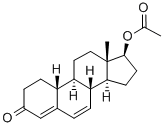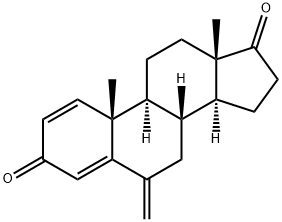PRODUCT Properties
| Melting point: | 95-98?C |
| Boiling point: | 457.4±45.0 °C(Predicted) |
| Density | 1.15±0.1 g/cm3(Predicted) |
| storage temp. | Controlled Substance, -20°C Freezer |
| solubility | Chloroform (Slightly), Methanol (Slightly) |
| form | Solid |
| color | Off-White to Pale Yellow |
| InChI | InChI=1/C20H26O3/c1-12(21)23-19-8-7-18-17-5-3-13-11-14(22)4-6-15(13)16(17)9-10-20(18,19)2/h3,5,11,15-19H,4,6-10H2,1-2H3/t15-,16+,17+,18-,19-,20-/s3 |
| InChIKey | OGUASZAAVFYYIL-SBVYDUMINA-N |
| SMILES | [C@@]12([H])CC[C@H](OC(=O)C)[C@@]1(C)CC[C@]1([H])[C@@]3([H])CCC(=O)C=C3C=C[C@@]21[H] |&1:0,4,9,13,15,25,r| |
| CAS DataBase Reference | 2590-41-2(CAS DataBase Reference) |
Description and Uses
Dehydronandrolone acetate is a critical precursor in the synthesis of C7-functionalized steroidal drugs such as the new anti-breast cancer drug Fulvestrant, the treatment of menopause and postmenopausal syndrome drug Tibolone, as well as the highly effective protein anabolic hormone Mibolone. Nandrolone as starting material was first subjected to simultaneous acylation with acetic anhydride and acetyl chloride to form the intermediate, which was then brominated with N-bromosuccinimide (NBS) under basic conditions to eliminate one molecule of HBr to produce Dehydronandrolone acetate (73% yield)[1].
Tibolone intermediate.
Safety
| Symbol(GHS) |  GHS08 |
| Signal word | Warning |
| Hazard statements | H361 |
| Precautionary statements | P501-P202-P201-P280-P308+P313-P405 |




